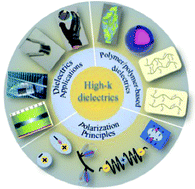Polymer-based dielectrics with high permittivity and low dielectric loss for flexible electronics
Abstract
With the increasing demand for miniaturized and flexible electronic devices, polymer-based materials have received tremendous attention due to the inherent advantages of polymers, such as their excellent flexibility, the diversity of options, and the designability of the molecular structures. Among the available polymer-based materials, high dielectric materials play important roles due to their wide application and huge influence on device performance, such as enhancing the sensitivity of capacitive sensors, reducing the driving voltage of thin-film transistors (TFTs), and increasing the energy density of film capacitors. In this work, starting from a brief introduction to the current state of polymer-based dielectrics, polarization principles (atomic polarization, electronic polarization, ionic polarization, dipolar polarization, and interfacial polarization), the structures of polymer-based dielectrics (linear polymers and cross-linked polymers for neat polymers, and core–shell structured nanoparticles and immiscible polymer blend matrices for polymer nanocomposites), and the application of solution-processed dielectrics in flexible electronic devices (organic field-effect transistor memory, film capacitors, dielectric elastomer actuators, and capacitive sensors) are carefully discussed, hoping to provide researchers with a more extensive and expansive understanding of this field of high dielectric polymers.



 Please wait while we load your content...
Please wait while we load your content...